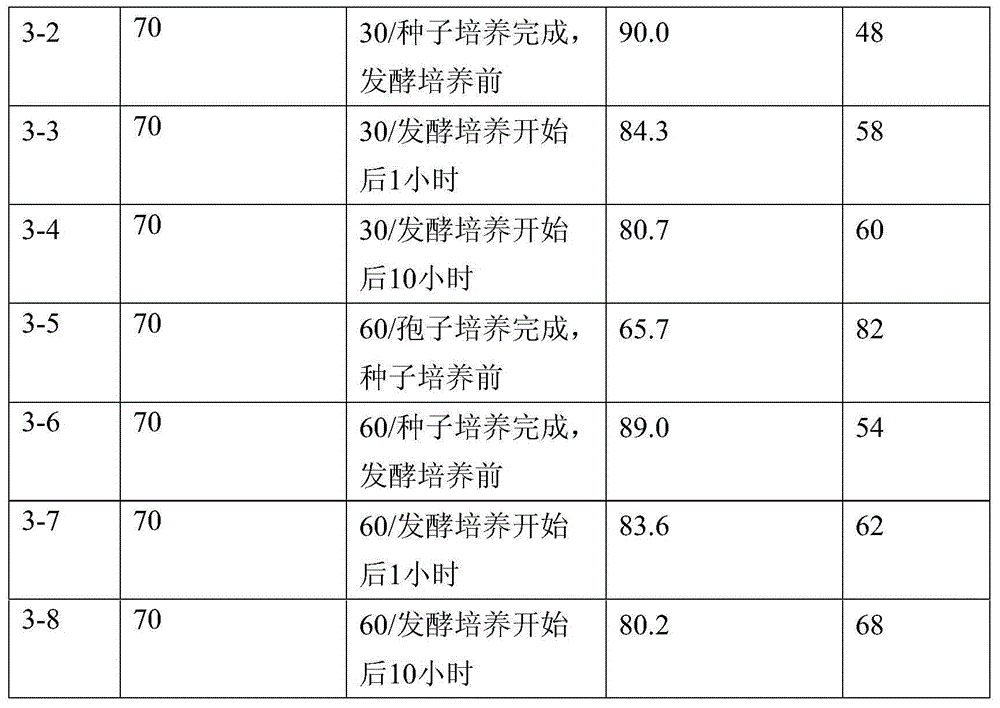Method for promoting conversion of plant sterols into 9 alpha-hydroxyandrostenedione by Mycobacterium fortuitum
A phytosterol and hydroxyl technology, applied in the field of ultrasonic vibration, can solve the problems of prolonged transformation time, poor contact between substrate and microbial cells, poor solubility, etc.
- Summary
- Abstract
- Description
- Claims
- Application Information
AI Technical Summary
Problems solved by technology
Method used
Image
Examples
Embodiment 1-3
[0055] Strain: Mycobacterium fortuitum ATCC35855.
[0056] Take 10 different batches of corn steep liquor and ferment them respectively according to the quantity and process in this example. Except corn steep liquor, other materials are the same batch of materials.
[0057] Seed culture stage:
[0058] Seed medium (per liter):
[0059]
[0060] Medium volume: 200ml / flask
[0061] Inoculum volume: Inoculate 3ml of cell suspension from agar slant per 200ml of new medium
[0062] Container: 1000ml conical flask
[0063] Stirring: Shaker (1”throw) 200rpm
[0064] Temperature: 30°C
[0065] Growth time: 72 hours culture
[0066]Note: A good culture organism is indicated if a yellow cell pellet forms at the bottom
[0067] method:
[0068] Inoculum for biotransformation was prepared in culture medium. Inoculate Erlenmeyer flasks from the agar surface (cultivated in glass test tubes), inoculate under sterile conditions, pipette sterile water (5 mL) onto the agar shaking ...
Embodiment 4
[0089] Method is similar to embodiment 1-3, but throws substrate concentration and becomes 4% (phytosterol 40g), and fermentation culture stage parameter changes as follows:
[0090] Biotransformation experiments were performed in stainless steel fermenters with efficient bottom agitation. The main parameters of the fermenter used are: the total volume of the fermenter is 10 liters, the working volume is 3 liters, the amount of inoculum is 0.4 L, the ventilation rate is 0.5 L / L / min, and the stirring is 400 rpm.
[0091] The experimental results are shown in the table below
[0092]
Embodiment 5
[0094] Method is the same as embodiment 4, but throws substrate concentration and becomes 7% (phytosterol 70g),
[0095]
[0096] Proved by the above examples, the preparation of 9α-hydroxyl-androst-4ene-3,17dione by MycobacteriumfortuitumATCC35855 as substrate by phytosterol composition, in the case of ultrasonic vibration, achieved better results, the conversion rate Significantly improved, thus through conventional technical methods, the yield and quality of the product can be significantly improved. Especially in the case of high-concentration feeding, such as 7%, the conversion rate is obviously better than the method without ultrasonic vibration through 2 times of ultrasonic vibration.
PUM
 Login to View More
Login to View More Abstract
Description
Claims
Application Information
 Login to View More
Login to View More - R&D
- Intellectual Property
- Life Sciences
- Materials
- Tech Scout
- Unparalleled Data Quality
- Higher Quality Content
- 60% Fewer Hallucinations
Browse by: Latest US Patents, China's latest patents, Technical Efficacy Thesaurus, Application Domain, Technology Topic, Popular Technical Reports.
© 2025 PatSnap. All rights reserved.Legal|Privacy policy|Modern Slavery Act Transparency Statement|Sitemap|About US| Contact US: help@patsnap.com



